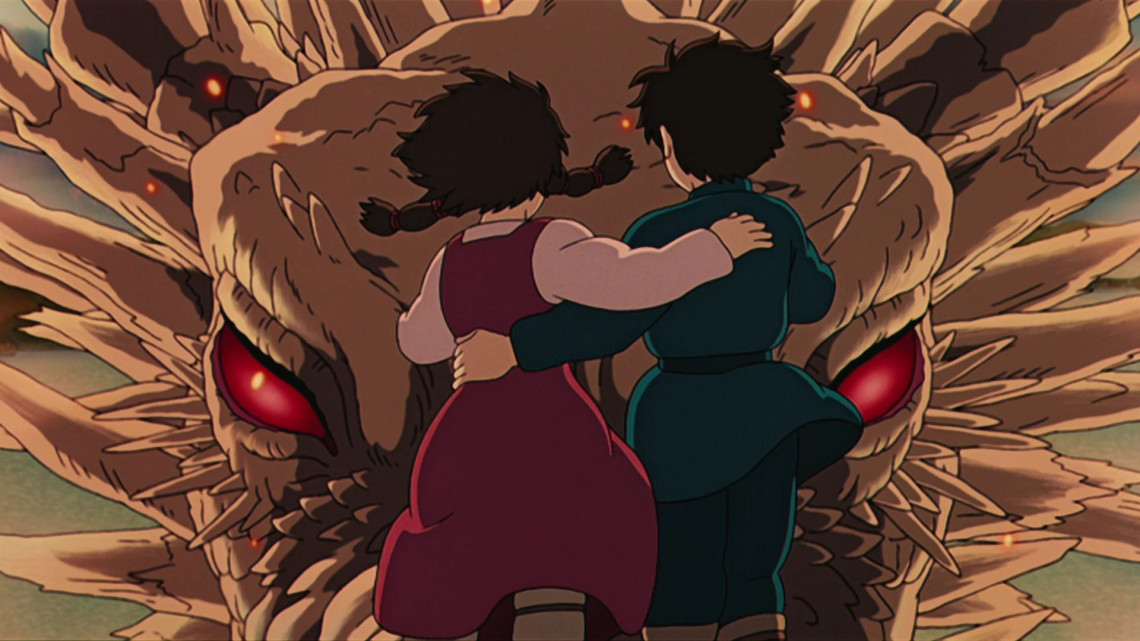The avatar for Studio Ghibli is Hayao Miyazaki, as much of an icon as Totoro ever was. He’s a Japanese Walt Disney in terms of being the public face of the company as he is a passionate filmmaker as well as being a pioneering hero in hand-drawn animation. But Miyazaki isn’t the only director at Ghibli; Isao Takahata has been nearly as prolific over the studio’s decades of feature production. Miyazaki first handed the reins over to his son, Goro, nearly a decade ago with the long-awaited adaptation of the Ursula LeGuin series Earthsea. The resulting film, Tales from Earthsea, may not be much of a faithful adaptation–LeGuin originally said she approved of the film in spite of it being different from her work, but she’s changed her tune over time. But what’s most surprising is that, relative to Ghibli’s other films, it’s something of a dud.
And that’s a shame, because the opening sequence is fairly attention-grabbing, starting as men aboard a ship watch in awe and horror as two dragons battle each other to the death and ending with the tortured protagonist Prince Arren stabbing his father the king to death in secret, leaving us to wonder what would drive the young man to patricide. Arren unsurprisingly soon flees the kingdom, winding up with the wizard Sparrowhawk and a physically scarred young woman named Therru, as they all attempt to figure out how and why their world of magic is out of balance. Why, for example, are those dragons fighting and killing each other? Why are men unable to control the meteorological elements anymore? And how is it that these questions are answered in a surprisingly perfunctory and dull fashion?
That’s the real letdown of Tales from Earthsea: in spite of the beauty that’s almost predictable at this stage of the Studio Ghibli canon, the story located inside those visuals unfolds with slack pacing and uninspired character relationships. The connection between Arren and Therru, or the connection between Arren and Sparrowhawk, or Sparrowhawk and his longtime friend Tenar, should be enough to make this film compelling. And if not that, the battle among wizards–Sparrowhawk and his rival Cob–should be enough. But the way that Goro Miyazaki brings all of these threads together is lifeless; it’s as if the younger Miyazaki took too greatly to heart the idea that Arren–as he reveals to Sparrowhawk at one point–has essentially lost the ability to feel anything, whether it’s joy or fear. This film is tragically as empty and hollow as its lead character.
A/V
The tale of the tape here is roughly similar to that of Porco Rosso and Pom Poko: the transfer from standard to high definition is quite remarkable. Having said that, it’s evident from the first frame that the job was likely a bit less challenging for Tales from Earthsea; its mid-2000s release is clear throughout, as there’s less grain and more of a digital base for the images. As with the other new Disney/Ghibli releases, there’s the unfortunate possibility that this film’s English-language subtitles are “dubtitles,” in that they derive from the English-language dub script instead of the original script. But even that, for anyone who holds this film dear, shouldn’t be enough to avoid the Blu-ray.
Extras
As with the other Ghibli films arriving on Blu-ray today, this one’s light on extras, except for a series of old trailers and the original Japanese storyboards. Also, for the truly interested, there’s an hourlong documentary on the film’s soundtrack. (However, the only of these extras that was redone for HD are the storyboards. It should come as no great shock that there are no new extras on any of these Blu-rays.)
Overall
As beautiful as it is, Tales from Earthsea is indeed something of a step down qualitatively for Studio Ghibli. The HD transfer is quite nice to look at, but unless you’re a completist, you can skip this Blu-ray.




















